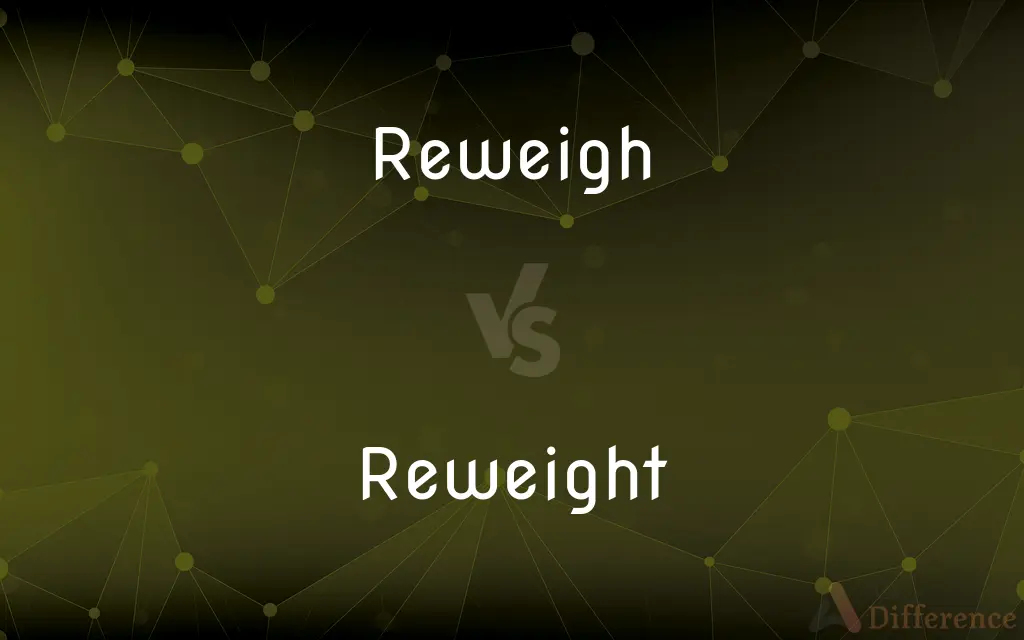Reweigh vs. Reweight — What's the Difference?
By Maham Liaqat & Urooj Arif — Updated on March 27, 2024
Reweigh involves measuring weight again to verify accuracy, whereas reweight applies adjustments to values or weights in data or statistical analysis.

Difference Between Reweigh and Reweight
Table of Contents
ADVERTISEMENT
Key Differences
Reweighing is the process of measuring the weight of an item or individual again, often to ensure the accuracy of the first measurement. This is commonly seen in contexts like shipping, where the weight of a package may be rechecked for billing accuracy. On the other hand, reweighting involves adjusting the weights or importance given to different elements within a dataset or statistical model. This adjustment is usually made to correct or optimize the representation of data or to address biases.
While reweighing is straightforward and requires the physical presence of the item being weighed, reweighting is a conceptual and computational process. It's applied in fields like machine learning, where the importance of features in a dataset may be adjusted to improve model performance. Whereas reweighing confirms or corrects an existing measurement, reweighting changes the underlying assumptions or calculations in a model or dataset.
Reweighing is often a final or verification step in a physical process, ensuring that the recorded weight matches the actual weight as closely as possible. It's a corrective action taken to minimize errors in measurement. Conversely, reweighting is a preparatory or iterative process, enhancing the analytical or predictive quality of a model before or during its development. It's proactive, aiming to refine data representation or model accuracy.
In practical terms, reweighing can affect the outcome directly related to weight, such as shipping costs or material requirements. It has tangible implications, potentially altering physical handling or financial charges. Reweighting, however, impacts the theoretical or analytical outcomes, influencing how data is interpreted or predictions are made. Its effects are seen in the quality of insights or decisions derived from the data.
The necessity of reweighing often arises from discrepancies or doubts about initial measurements, emphasizing the importance of precision in physical processes. Reweighting, by contrast, is necessitated by the need to adjust models or analyses to better reflect reality or achieve specific analytical goals, highlighting the evolving nature of data-driven decision-making.
ADVERTISEMENT
Comparison Chart
Definition
Measuring weight again for verification.
Adjusting weights/values in data or analysis.
Context
Physical measurement.
Data analysis or statistical modeling.
Purpose
Ensure accuracy of physical weight.
Optimize or correct data representation.
Process
Physical measurement with scales.
Computational adjustments.
Field of Application
Shipping, manufacturing, sales.
Machine learning, statistics, research.
Compare with Definitions
Reweigh
Measuring weight again.
The courier had to reweigh the package due to a discrepancy.
Reweight
Adjusts weight distribution.
The team had to reweight the cargo for even distribution.
Reweigh
Ensures accuracy.
The chef decided to reweigh the ingredients for precision.
Reweight
Aims for optimization.
The algorithm was reweighted to improve fairness in results.
Reweigh
Often involves scales.
The luggage was reweighed at the airport check-in.
Reweight
Often requires judgment.
The coach reweighted the training regimen priorities.
Reweigh
A repeat action.
The shipment was reweighed after repackaging.
Reweight
Can involve recalibration.
Researchers reweighted the variables in their analysis.
Reweigh
Used in various contexts.
Scientists reweigh samples to ensure data reliability.
Reweight
Affects physical or conceptual balance.
The editor reweighted the sections of the article for better flow.
Reweigh
Weigh (something) again.
Reweight
To reassign weight or importance to; to adjust the relative weighting of.
Reweigh
(transitive) To weigh again; to weigh something that has already been weighed.
Take it out of the box and reweigh it.
Reweight
To replace or adjust weights that are attached to something.
Reweight
To adjust the weighting given to a value.
Reweight
(horseracing) To adjust or reassign the handicap weight.
Common Curiosities
Is reweighing common in industries other than shipping?
Yes, it's also common in food preparation, scientific research, and any context requiring precise weight measurements.
What does it mean to reweight a statistical model?
It involves adjusting the significance or influence of different factors within the model.
Can reweighing affect the outcome of a process?
Yes, accurate reweighing can ensure correct charges, prevent errors, and maintain consistency.
How often should one reweigh to ensure accuracy?
It depends on the context and importance of precision; some scenarios may require frequent reweighing.
Can reweighting be subjective?
In conceptual applications, such as adjusting emphasis in analysis, it can involve subjective judgment.
What tools are used for reweighing?
Scales and balance systems designed for precise weight measurement.
How does reweighting impact algorithm performance?
Reweighting can improve algorithm accuracy or fairness by adjusting emphasis on certain data points.
Is reweighting a one-time process?
No, it may need to be repeated as conditions or priorities change.
Why might someone reweigh an item?
To verify the initial weight measurement or ensure accuracy after changes.
What might prompt a need to reweight in a physical context?
Imbalance issues, such as uneven load distribution affecting vehicle stability.
Can reweighing correct errors?
Yes, if discrepancies are found, reweighing can help correct them.
Why is reweighting important in research?
It ensures that the analysis accurately reflects the importance of different factors.
Does reweighing require special equipment?
It requires accurate weighing equipment appropriate for the item's size and weight.
How do professionals decide how to reweight factors?
Through analysis, experience, and considering the goals of the project or model.
What challenges might arise during reweighting?
Determining the optimal weight distribution or emphasis can be complex and context-dependent.
Share Your Discovery

Previous Comparison
Solstice vs. Equinox
Next Comparison
Acknowledge vs. ConfirmAuthor Spotlight
Written by
Maham LiaqatCo-written by
Urooj ArifUrooj is a skilled content writer at Ask Difference, known for her exceptional ability to simplify complex topics into engaging and informative content. With a passion for research and a flair for clear, concise writing, she consistently delivers articles that resonate with our diverse audience.
















































